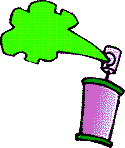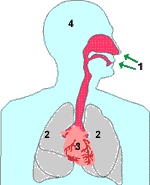| ||
 QUESTION: What do nail polish,
paint and glue have in common?
QUESTION: What do nail polish,
paint and glue have in common?
ANSWER: They can:
|
Extremely Flammable Harmful or Fatal If Swallowed Vapors May Cause Fire | |
| ||
 QUESTION: What do nail polish,
paint and glue have in common?
QUESTION: What do nail polish,
paint and glue have in common?
ANSWER: They can:
|
Extremely Flammable Harmful or Fatal If Swallowed Vapors May Cause Fire | |
| Variety of Inhalants | ||
| Product | Chemical Content | |
|---|---|---|
| Hair Spray | Fluorinated hydrocarbons; propane; isobutane |  | Nitrous Oxide | Nitrous Oxide | Cleaning Fluids | Chlorinated hydrocarbons; naphtha | Typewriter Correction Fluid | Trichloroethane; trichloroethylene | Nail Polish Remover | Acetone; aliphatic acetates; benzene | Gasoline | Hydrocarbons; tetraethyl lead | Glue; rubber cement | Toluene; acetone, benzene; xylene; ethanol; chloroform | Paint/Paint Thinner | Toluene; methylene chloride; benzene, ethanol | Lighter Fluid | Hydrocarbons | Room Deodorizers | Amyl, butyl and isobutyl nitrite | Marker pens | Toluene; xylene |
Effects of Inhalants on the Nervous System When
vapors are inhaled (1),
they are absorbed through the lungs (2) and enter the bloodstream (3).
Once in the bloodstream, the chemicals travel to the brain (4) and other
tissues throughout the body. Most inhalants that are abused depress the
functioning of the nervous system. However, the effects of each inhalant
are difficult to determine because each product in made up many different
chemicals and each person may breathe in different amounts of each
chemical. Nevertheless, these chemicals do have significant effects on
the nervous system. When
vapors are inhaled (1),
they are absorbed through the lungs (2) and enter the bloodstream (3).
Once in the bloodstream, the chemicals travel to the brain (4) and other
tissues throughout the body. Most inhalants that are abused depress the
functioning of the nervous system. However, the effects of each inhalant
are difficult to determine because each product in made up many different
chemicals and each person may breathe in different amounts of each
chemical. Nevertheless, these chemicals do have significant effects on
the nervous system.Some of the effects of inhalants are simliar to those of alcohol. The immediate effects of inhalants include:
Long term use of inhalants can cause:
|
Nervous System Targets of Inhalants |
| Inhalants may affect different parts the brain
and nervous system and may cause a variety of sensory, motor,
psychological and emotional problems. One major effect of inhalants is
the destruction of the myelin sheath that
surrounds neurons. This can result in problems in the normal transmission
of impulses through neurons and cell death.
|
Did you know? |
Nitrous oxide was discovered in 1776 by Sir Joseph Priestley. In 1799, Sir Humphrey Davy suggested that nitrous oxide could be used during surgery to reduce pain. |

 For more
information about inhalant abuse, see: For more
information about inhalant abuse, see:
|

| GO TO: | Alcohol | Amphetamines | Caffeine | Cocaine |
| Heroin | Inhalants | LSD | Marijuana | |
| Nicotine | Ecstasy | Rohypnol | 1,4-Butanediol | |
| GHB | Barbiturates | PCP | Hallucinogenic Mushrooms | |
![[email]](./gif/menue.gif) Send E-mail |
 Get Newsletter |
 Search Pages |
 Donate to Neuroscience for Kids |